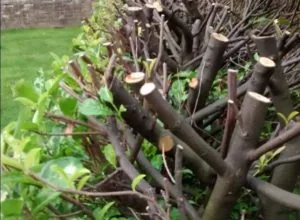HALF PRICE SALE ENDS AT MIDNIGHT TONIGHT
***TODAY ONLY – GET AN EXTRA 10% OFF SALE PRICES WITH CODE FLASH10***
Menu
HALF PRICE SALE ENDS AT MIDNIGHT TONIGHT
***TODAY ONLY – GET AN EXTRA 10% OFF SALE PRICES WITH CODE FLASH10***
You are here: Home »
Laurel Hedges are one of the most responsive species to the major surgery of hedge restoration. Even hedges that appear to be hopelessly overgrown can be drastically reduced in size, and the unpromising woody stems will sprout with new foliage.

Firstly, get to know your plant. Explore and understand which fertiliser is best for your Laurel Hedge Plant, or its ideal soil and site type; becoming aware of these factors will contribute to its maintenance.
The best time to cut the plants back is in early Spring, well before the hedge is coming into growth (but provided the weather is not cold and frosty, if it is, then wait until conditions improve). Start by reducing the height using a taught string line to keep it level. The height can be reduced drastically by several metres if necessary (even taking the plants back to stumps), although the work can be split over a couple of seasons if you are cutting the height back by more than one third.
Explore our guide on the Best Time to Trim a Laurel Hedge for further information on important details, such as how many times to trim a laurel hedge yearly, and why you should be trimming it.
The sides may be cut back at the same time, or you can choose to reduce one side at a time; it depends on how sensitive you are to the temporary lack of privacy that will inevitably follow for 2 or 3 seasons if all the work is done at once. You can cut back the sides by as much as several metres if necessary, taking care to remove any diseased and dead wood as you go and making sure all the large cuts are clean- without any ragged edges that will encourage disease to enter.
Once the hedge has been cut back, it’s a good idea to give it a good feed with a general fertiliser such as Growmore, if possible, forking it into the top 5cm of the soil around the hedge, followed up with a good thick mulch of wood chips or garden compost after watering the fertiliser in well.
It’s important to remember that every Laurel Hedge will grow at different rates, depending on different factors. To learn more about the growth rate of your Laurel Hedge Plant variety, read our helpful guide on How Fast Laurel Hedges Grow.
New shoots should start to appear from the bare wood within a couple of months; any long whippy growths should be pinched at the tips to encourage bushiness. Depending on how comfortable you are with the amount of privacy the new growth offers, you may choose to cut the other half of the hedge back the following Spring or leave it another year. Either way, it should be possible to fully rejuvenate an old hedge within 3 or 4 years.
You may also find the following guides useful for keeping your Laurel Hedges in the best shape possible: How To Make Your Laurel Grow Faster and Common Pests Diseases and Problems with Laurel Hedge Plants for more information on getting the best out of your Laurel Hedge Plants.